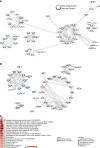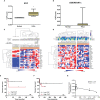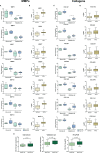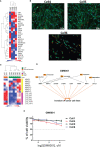Interplay Between Immune and Cancer-Associated Fibroblasts: A Path to Target Metalloproteinases in Penile Cancer
- PMID: 35928876
- PMCID: PMC9343588
- DOI: 10.3389/fonc.2022.935093
Interplay Between Immune and Cancer-Associated Fibroblasts: A Path to Target Metalloproteinases in Penile Cancer
Abstract
Extracellular matrix (ECM) remodeling and inflammation have been reported in penile carcinomas (PeCa). However, the cell types and cellular crosstalk involved in PeCa are unexplored. We aimed to characterize the complexity of cells and pathways involved in the tumor microenvironment (TME) in PeCa and propose target molecules associated with the TME. We first investigated the prognostic impact of cell types with a secretory profile to identify drug targets that modulate TME-enriched cells. The secretome analysis using the PeCa transcriptome revealed the enrichment of inflammation and extracellular matrix pathways. Twenty-three secreted factors were upregulated, mainly collagens and matrix metalloproteinases (MMPs). The deregulation of collagens and MMPs was confirmed by Quantitative reverse transcription - polymerase chain reaction (RT-qPCR). Further, the deconvolution method (digital cytometry) of the bulk samples revealed a high proportion of macrophages and dendritic cells (DCs) and B cells. Increased DCs and B cells were associated with better survival. A high proportion of cancer-associated fibroblasts (CAFs) was observed in low-survival patients. Patients with increased CAFs had decreased immune cell proportions. The treatment with the MMP inhibitor GM6001 in CAF cells derived from PeCa resulted in altered cell viability. We reported a crosstalk between immune cells and CAFs, and the proportion of these cell populations was associated with prognosis. We demonstrate that a drug targeting MMPs modulates CAFs, expanding the therapeutic options of PeCa.
Keywords: cancer-associated fibroblasts; penile cancer; response to therapy; secretome; transcriptome.
Copyright © 2022 Cury, Kuasne, Souza, Muñoz, da Silva, Lopes, Scapulatempo-Neto, Faria, Delaissé, Marchi and Rogatto.
Conflict of interest statement
The authors declare that the research was conducted in the absence of any commercial or financial relationships that could be construed as a potential conflict of interest.
Figures





Similar articles
-
Penile Cancer-Derived Cells Molecularly Characterized as Models to Guide Targeted Therapies.Cells. 2021 Apr 6;10(4):814. doi: 10.3390/cells10040814. Cells. 2021. PMID: 33917394 Free PMC article.
-
Crosstalk between cancer-associated fibroblasts and immune cells in the tumor microenvironment: new findings and future perspectives.Mol Cancer. 2021 Oct 11;20(1):131. doi: 10.1186/s12943-021-01428-1. Mol Cancer. 2021. PMID: 34635121 Free PMC article. Review.
-
Secretome profiling of oral squamous cell carcinoma-associated fibroblasts reveals organization and disassembly of extracellular matrix and collagen metabolic process signatures.Tumour Biol. 2016 Jul;37(7):9045-57. doi: 10.1007/s13277-015-4629-y. Epub 2016 Jan 13. Tumour Biol. 2016. PMID: 26762409
-
Spatial transcriptomics atlas reveals the crosstalk between cancer-associated fibroblasts and tumor microenvironment components in colorectal cancer.J Transl Med. 2022 Jul 6;20(1):302. doi: 10.1186/s12967-022-03510-8. J Transl Med. 2022. PMID: 35794563 Free PMC article.
-
Cancer associated-fibroblast-derived exosomes in cancer progression.Mol Cancer. 2021 Dec 1;20(1):154. doi: 10.1186/s12943-021-01463-y. Mol Cancer. 2021. PMID: 34852849 Free PMC article. Review.
Cited by
-
Secretome of Stromal Cancer-Associated Fibroblasts (CAFs): Relevance in Cancer.Cells. 2023 Feb 15;12(4):628. doi: 10.3390/cells12040628. Cells. 2023. PMID: 36831295 Free PMC article. Review.
-
Inflammation in Penile Squamous Cell Carcinoma: A Comprehensive Review.Int J Mol Sci. 2025 Mar 19;26(6):2785. doi: 10.3390/ijms26062785. Int J Mol Sci. 2025. PMID: 40141426 Free PMC article. Review.
-
The distinct landscape of tumor immune microenvironment in homologous recombination deficient cancers.Biomark Res. 2025 Aug 20;13(1):108. doi: 10.1186/s40364-025-00814-x. Biomark Res. 2025. PMID: 40830526 Free PMC article. Review.
References
LinkOut - more resources
Full Text Sources
Molecular Biology Databases

